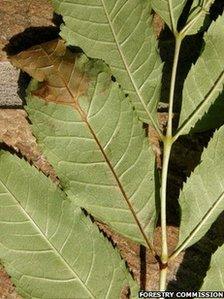The heartbreak of watching the slow death of ash trees
- Published
- comments
Chris Jackson assesses the impact of ash dieback on woodlands in the north of England
On a country walk we all need to keep our eyes peeled. The deadly chalara fungus is creeping its way across Britain and is threatening to wipe out ash trees it infects.
At primary school I remember learning how to identify trees by their leaves or bark.
The one I was most interested in spotting was the one that would deliver conkers; the horse-chestnut.
Sad to say the ash was no longer lodged in my memory banks when news first broke of this new threat to our woodland.
Once pointed out it's relatively easy.
In younger ash there is a distinctive smooth silver grey bark and sooty black buds.
The branches split off at directly opposing points and the stems bear between nine and 13 leaves in symmetrical pairs with a lone one at the tip.
The Forestry Commission website, external has a more detailed guide.
Not only are we being asked to look out for ash, we are also being urged to identify ones that might be infected.
When in leaf it's easier to spot because it seems as if the foliage has been damaged by a severe frost and turns limp and black.
In winter of course healthy and sick ash trees are difficult to tell apart as the leaves will all have fallen to the ground.
A tell tale image is a diamond like mark near a branch joint.
You should report any sightings of ash dieback, external to the Forestry Commission.
Monitoring the spread
As the Inside Out programme discovers tonight, there is a high-tech means of identifying stricken trees using equipment originally designed for checking war zones for chemical weapons.

In Denmark 90% of ash trees have succumbed to the disease
But this all feels a bit like watching helplessly by as the black death moved relentlessly across Europe centuries ago.
There is no cure for ash dieback as it's more commonly known. All we can do is monitor and try and limit its spread.
If Denmark's example is anything to go by, then we can expect 90% of our ash to succumb. That equates to around 5% of British woodland.
The good news if there is any in this situation, is signs that some ash appear to be either resistant or tolerant of the fungus and do survive.
In evolutionary terms it is survival of the fittest in action.
It might be time to make sure primary kids can spot an ash tree the next time they are out in the woods.
Inside Out North East and Cumbria is on BBC One at 19:30 GMT, Monday, 17 December, 2012.